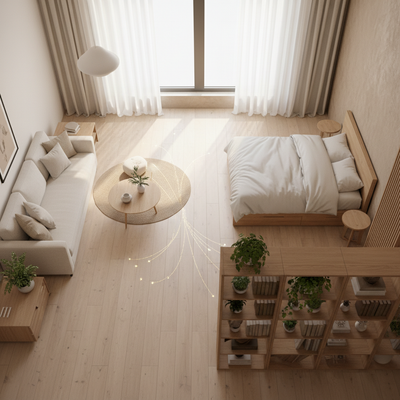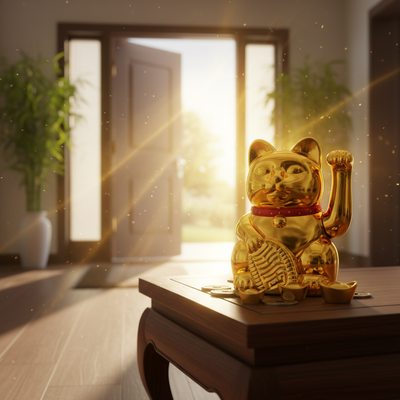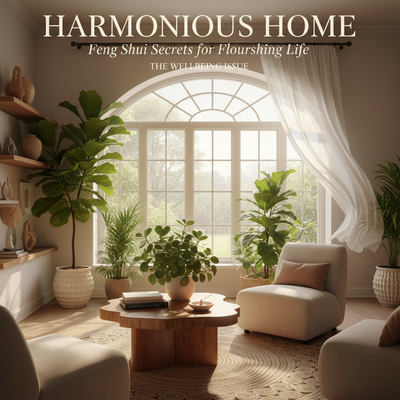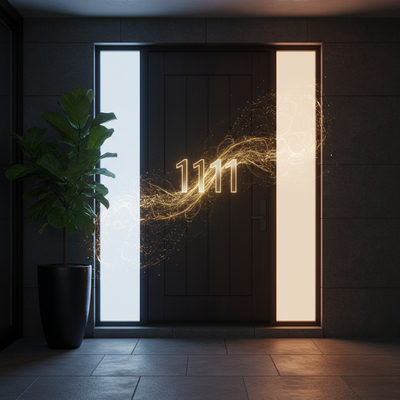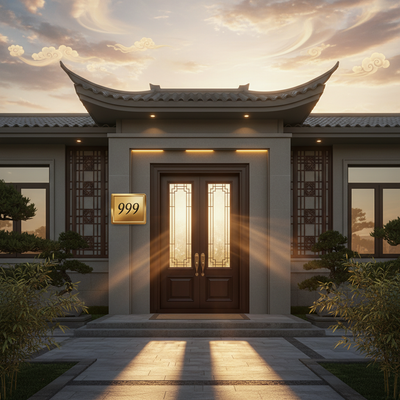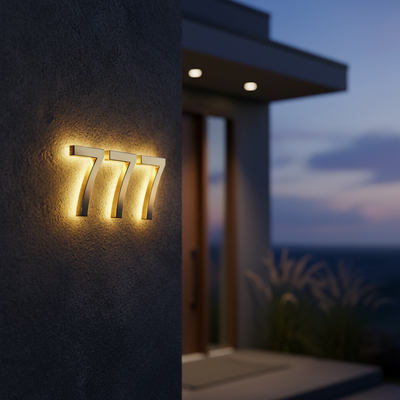Your Home's First Impression
Your home's outside appearance is its public face. It's the first thing you see when you come home and the last thing you see when you leave. In Feng Shui, this front view is more than just looking good from the street. It's the main way your home gets energy, called Chi, from the world around it. The colors you pick aren't just for decoration—they are strong tools that can either bring in positive, helpful Chi or create energy problems. This guide gives you a clear, complete plan for choosing the best feng shui exterior house colors for a north-facing home. It will help you create a space that supports your life's path.
For those who want a quick answer, here are the main suggestions for a home that faces North:
- Best Colors (Helpful): White, grey, and all metallic shades. These belong to the Metal element.
- Good Colors (Balanced): Black and all shades of dark blue. These belong to the Water element.
- Colors to Avoid: Yellows, browns, and beiges (Earth element), as well as reds, oranges, and purples (Fire element).
Understanding the "Why"

To make smart and effective choices, you need to understand the reasons behind these suggestions. Feng Shui is a logical system based on watching how energy flows in the natural world. By learning this logic, you move from just following rules to making informed decisions that are right for your specific home.
The North Direction
In traditional Feng Shui, every compass direction connects to a specific element, a life area, and a matching energy pattern, called a Gua. The North direction naturally links to the Water element. The life area it controls is Career and Path in Life, also known as the Kan Gua.
This area affects your work life, chances for moving up, business success, and your overall journey through life. When the energy in this area is strong and balanced, your path feels smooth, opportunities come to you, and you handle challenges with clarity and purpose. By choosing outside colors that support the North's Water element, you are actively feeding the energy that controls your career and life's mission.
The Five Element Theory
The foundation of all Feng Shui color and material choices is the Five Element Theory, or Wu Xing. This theory explains how the five elements—Water, Wood, Fire, Earth, and Metal—work with each other in constant, circular relationships. For a north-facing home, we care most about the cycles that involve the Water element.
The Productive Cycle explains how one element creates or feeds another. This is the best relationship because it creates positive, supportive energy.
- Productive Cycle: Metal -> Water -> Wood -> Fire -> Earth -> Metal
- For our needs, the key relationship is that Metal creates Water. Think of water drops forming on a cool metal surface. This is how ancient people saw Metal making Water. This is the main reason Metal element colors are the best choice for a north-facing home.
The Destructive Cycle explains how one element controls or destroys another. Using colors from a destructive element can create blocks, drain energy, and lead to problems.
- Destructive Cycle: Water -> Fire -> Metal -> Wood -> Earth -> Water
- The key relationship here is that Earth dams or soaks up Water. Think of how a dam made of earth stops a river's flow. This is why Earth element colors should be avoided for a north-facing home.
A third relationship, often called the Clashing or Weakening Cycle, is also important. In this case, Water puts out Fire. This creates direct conflict and energy stress, making Fire element colors very unsuitable.
The Best Color Palette
Now that we understand the "why," let's explore how to use these ideas practically. Your goal is to pick a color palette that either feeds the Water element (the Productive Cycle) or works well with it.
Top Choice: Metal Element
The number one suggestion for a north-facing home's outside is the palette of the Metal element: whites, greys, and metallics. According to the Productive Cycle, Metal creates Water. By painting your home in Metal element colors, you are basically creating an energy factory that constantly makes and feeds the helpful Water energy your home needs. This gives a powerful boost to your career and life path goals.
-
White: This color represents purity, clarity, and new beginnings. A white outside feels clean, spacious, and open to possibilities. It's a flexible choice that works with almost any building style. Off-whites and creamy whites offer a softer, more welcoming feel while still keeping the Metal element's helpful qualities.
-
Grey: Grey represents sophistication, wisdom, and balance. It is an excellent neutral that can range from a light, airy silver to a deep, grounding charcoal. Grey provides a stable and calm energy, excellent for making sound work decisions. It serves as a fantastic main color that allows accent colors to stand out.
-
Metallics: While you likely won't paint your entire house silver, metallic finishes on trim, light fixtures, railings, or door hardware are a powerful way to bring in the Metal element. These finishes add a touch of precision, efficiency, and brilliance, reflecting the qualities of a sharp, focused mind.
Balanced Choice: Water Element
The second-best option is to use the colors of the Water element itself: black and dark blue. Using the element that matches the direction creates a balanced resonance, strengthening the natural energy of the North. This approach is about matching the energy to make it stronger.
-
Black: Black is a color of power, depth, and thinking inward. It represents the vast, deep potential of the Water element. While a fully black house can be a bold building statement, black is very powerful when used as an accent. A black front door on a north-facing home is a classic Feng Shui application, acting as a strong portal for career-improving Chi.
-
Dark Blue: For those who find black too intense, dark blue is an excellent alternative. It carries the energy of calm, wisdom, and peace. Shades like navy, indigo, and midnight blue bring to mind the deep ocean, promoting a sense of tranquility and deep knowledge. Dark blue works beautifully for shutters, trim, or the front door.
To help you picture these choices, here is a summary of the best options.
| Element | Colors | Feng Shui Reasoning | Best For... |
|---|---|---|---|
| Metal | White, Off-White, Grey, Silver | Productive Cycle: Metal creates Water, feeding the North's energy. | Main outside color, trim, garage doors. |
| Water | Black, Charcoal, Dark Blue | Balanced: Matches the North's natural element, strengthening it. | Front door, shutters, bold accents. |
Colors to Use with Care
Just as important as knowing which colors to use is knowing which to avoid. Choosing a color from a clashing or destructive element can accidentally create energy friction right at the entrance of your home, potentially leading to stagnation or stress.
Avoid: Earth Element Colors
The colors of the Earth element include all shades of yellow, brown, beige, sand, and terracotta. According to the Five Element Destructive Cycle, Earth absorbs or dams Water. When you paint a north-facing home in these colors, you are symbolically placing a dam in front of your career path.
This can show up as a feeling of being stuck, experiencing repeated obstacles, or finding that opportunities dry up. The energy of the Earth element is heavy, stable, and grounding. While this is helpful in other situations, for the flowing, adaptable Water energy of the North, it acts as a significant block. We strongly advise against using these as the main color for your home's body or front door.
Avoid: Fire Element Colors
The Fire element is represented by reds, oranges, bright purples, and hot pinks. The relationship between Water and Fire is one of direct conflict: Water puts out Fire. Painting your home's outside in a Fire color creates a constant state of energy stress right at your front door.
This clashing energy can show up in your life as arguments, burnout, high-pressure situations that feel overwhelming, or a loss of reputation. The energy is unstable and unpredictable. While a red door is good for a south-facing (Fire element) home, it is one of the worst choices for a north-facing home. These colors should be avoided completely for any major surfaces.
Use Sparingly: Wood Element
The Wood element is represented by all shades of green and some lighter, bright blues. The relationship here is not destructive, but rather draining. In the Productive Cycle, Water feeds Wood. This means that the Water element's energy is used up to support the Wood element.

If you use too much green on the outside of a north-facing home, you can slowly drain the energy needed for your career and life path. It's like having a small leak in your energy reserves. For this reason, we recommend using Wood element colors only as minor accents. The natural place for this is in your landscaping—shrubs, trees, and potted plants provide a healthy, balanced dose of the Wood element without overwhelming the home's primary energy. Avoid green for the main house color, trim, or front door.
Advanced Color Strategy
Truly excellent Feng Shui application goes beyond a simple list of good and bad colors. It involves a strategic and detailed approach to creating a palette that is not only energetically correct but also beautiful and sophisticated.
The Power of Tones
The suggestion "grey" or "blue" is just the beginning. The specific tone and shade you choose have a significant impact on the feeling, or Chi, of your home. A light, airy grey creates a different energy than a deep, grounding charcoal. A crisp, pure white feels spacious and modern, while a soft, creamy off-white feels more welcoming and gentle.
When selecting your colors, consider the feeling you want to create. Do you want your career to feel dynamic and sharp? A crisp white with black accents might be perfect. Do you seek more wisdom and calm in your work life? A medium grey with a navy blue door could be more appropriate. This layer of detail allows you to personalize the Feng Shui application to your specific intentions.
The 60-30-10 Rule
A classic interior design principle, the 60-30-10 rule, can be brilliantly adapted for a Feng Shui outside palette to create balance and visual harmony.
-
60% Main Color: This is the dominant color of your home's body. For a north-facing house, this should be a Metal element color. A soft grey, a warm off-white, or a classic white are all excellent choices to form the foundation of your palette. This provides the primary feeding energy.
-
30% Secondary Color: This color is used for larger accents like trim, shutters, and garage doors. You can use a contrasting Metal color (e.g., a darker grey on a white house) or a balanced Water element color. For instance, charcoal grey shutters or a deep blue garage door would powerfully support the main color.
-
10% Accent Color: This is your focal point, and in Feng Shui, the focal point of the outside is almost always the front door—the "Mouth of Chi." This is the perfect place to make a bold statement with a powerful Water element color. A glossy black front door is a classic and strong choice, drawing strong, positive Chi directly into your home and life path sector.
Texture and Material
Finally, remember that elements are expressed not just in color but also in texture and material. You can layer these elemental energies for an even more powerful effect.
-
Metal: Strengthen your color choice with actual Metal element materials. This includes brushed nickel or chrome light fixtures, metal railings, a metal roof, or sleek aluminum house numbers.
-
Water: Introduce the Water element through form and material. A walkway made of dark, flowing slate tiles can copy the flow of a river. Glass, especially wavy or reflective glass panels in or around the door, also represents the Water element.
By combining color, shade, material, and proportion, you create a sophisticated, multi-layered design that is both beautiful and deeply supportive of your home's energy.
Putting It All Together
With this knowledge, you are ready to make a confident choice. The process can be broken down into a simple, practical action plan.
Your 4-Step Action Plan
-
Confirm Your Facing Direction: This is the most critical first step. Stand in your front doorway looking out and use a reliable compass (a smartphone app is sufficient) to determine the precise direction your home faces. Don't rely on guesswork. Your home must face within the North range (approximately 337.5 to 22.5 degrees) for these guidelines to apply.
-
Review Recommended Palettes: Look again at the Metal (feeding) and Water (balanced) color families. Gather paint chips and inspiration photos that fall within these palettes. Think about the feeling you want to create.
-
Consider Your Environment: A home does not exist alone. Look at the fixed elements you cannot change, such as your roof color or any existing stonework or brick. Your chosen palette should work well with these. Also, consider your neighborhood's look. While your home should be unique, it should also feel like it belongs.
-
Always Test Your Colors: Never choose a color from a small paint chip. Purchase sample pots and paint large swatches (at least 2x2 feet) on different sides of your home's outside. Look at them at various times of day—in the bright morning sun, the direct light of noon, and the soft light of the evening. Colors can change dramatically, and this is the only way to be sure you'll love the final result.
When to Call an Expert
While these guidelines are powerful and effective for most north-facing homes, some situations can create a more complex energy map where general advice may not be enough. Personal Kua numbers (based on your birth date), the age of the home (which determines its "Period" in Flying Star Feng Shui), or unique building features can all add layers of complexity.
This is where a personalized consultation becomes invaluable. For instance, our team at THE QI FLOW recently consulted on a north-facing property where the homeowner's personal element was strong Fire. A purely Water-Metal theme, while correct for the house, would have created a personal clash for the owner, as Water clashes with Fire. In that case, we developed a detailed solution using a specific shade of off-white (Metal) as the main color to gently feed the home's Water element. To balance the owner's energy, we then added specific Wood element shapes in the landscaping and a particular shade of green on a small, hidden garden gate. This strategy supported the home's Chi while also balancing it with the owner's personal energy. If you suspect your situation is complex, a professional consultation can provide a tailored solution.
Conclusion: Paint with Intention
Choosing an outside color for your home is a significant decision. By applying the principles of Feng Shui, you can transform this choice from a purely aesthetic one into a powerful act of intention. For your north-facing home, an outside dressed in the feeding colors of the Metal element (whites and greys) or the balanced colors of the Water element (black and dark blue) will actively support your career, attract new opportunities, and smooth your path in life. By avoiding the draining and clashing energies of Earth and Fire colors, you protect your home's vital energy. You now have the knowledge to paint your home with confidence, creating a beautiful front that is also a powerful beacon for positive Chi.
